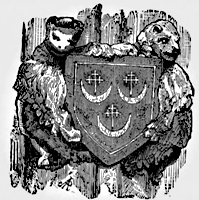Chapter XX: Remains
King Robert the Bruce died in 1329, and Sir Alan of Cathcart and his old companion in arms, the good Sir James of Douglas, sailed in the following year for the Holy Land with the King's heart. Sir James was killed in Spain in conflict with the Moors, as every reader of Scottish history knows. Sir Alan came back with the heart of the King,[20] and the pillar in the Abbey—then being restored after its destruction by the English—commemorates his safe return.

The cross crosslets above the crescents on the shield may have some reference to the conflict with the Moors in which the Douglas fell. Thus this pillar carries us away in thought to the plains of Andalusia and to this most romantic episode in Scottish story. The arms are undoubtedly those of the Cathcarts, and there is nothing improbable in the tradition, which we have thought right to give.
In the centre of the Chapel of St. Mirin stands the supposed tomb of Marjory, the daughter of King Robert the Bruce, through whom the Stewarts came to the throne of Scotland. It is of beautiful workmanship, and is in every way worthy of inspection. It was reconstructed by Dr. Boag, one of the ministers of the Parish, from fragments which he found lying about in the neighbourhood of the Abbey,[21] and placed by him in its present position. The tomb is an altar tomb with the recumbent figure of a woman resting on a pillow; over her head is an ornamental canopy, with a sculpture of the crucifixion. Round the tomb is a series of compartments filled with boldly sculptured figures of ecclesiastics, and shields with armorial bearings. On a scroll is written the name of Robert Wyschard, and under another figure, that of an abbot celebrating at an altar, is inscribed the name, Johes d Lychtgw, which is repeated below another kneeling figure. The stone at the head of the monument is divided into three compartments, each containing a shield. The shield on the right bears the fess cheque between three roses,—that on the left the fess cheque surmounted by a lion rampant, and the one in the middle two keys en saltire between two croziers en pale.
[20] The band of knights who accompanied Douglas is supposed to have been composed of the following persons:—
Sir William Keith—Not in action ; suffering from a broken arm.
Sir William Saint Clair of Rosalyn, Killed in action.
Sir Robert Logan, Killed in action.
Sir Walter Logan, Killed in action.
Sir Alan of Cathcart—Probably returned to Scotland with Keith.
Sir Symon Locard of Lee—Went on to the Holy Land.
The centre pillar is what is sometimes called a founder's pillar. For example, amongst many others, Bishop Cameron's arms are on the spire, which he constructed, of Glasgow Cathedral. It is said by Nesbit that of old the Cathcarts carried only crescents, and that afterwards they added the cross-crosslets. It is highly probable that at an earlier period a Cathcart assumed the well-known Moslem badge, the crescent, in consequence of some distinguished achievement in the Holy Land, and that, in addition, Sir Alan the VI. assumed the cross-crosslets fitché on his return from his pilgrimage with the heart of Bruce. In regard to the date of the Cathcart pillar, there can be but little doubt; the shape of the shield, the architecture generally, and one minute but suggestive circumstance, the lion supporters of the shield, all point to the time of Sir Alan of Cathcart the VII. The idea, in all probability, was that of the pilgrim father, Sir Alan VI., carried out by his son.—MS. of Lord Cathcart.
[21] See Transactions of the Society of the Antiquaries of Scotland, Vol. II., p. 456, where there is a Paper by Dr. Boag upon this tomb. See also “Saint Mirin,” p. 22-23, and Ramsay's “Views of Renfrewshire.”